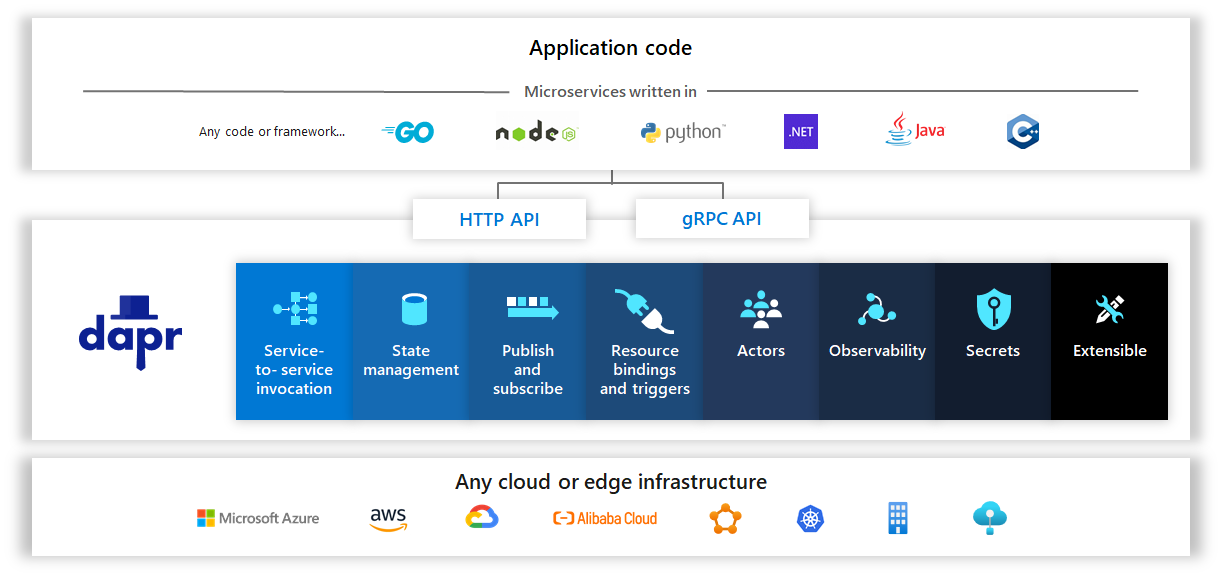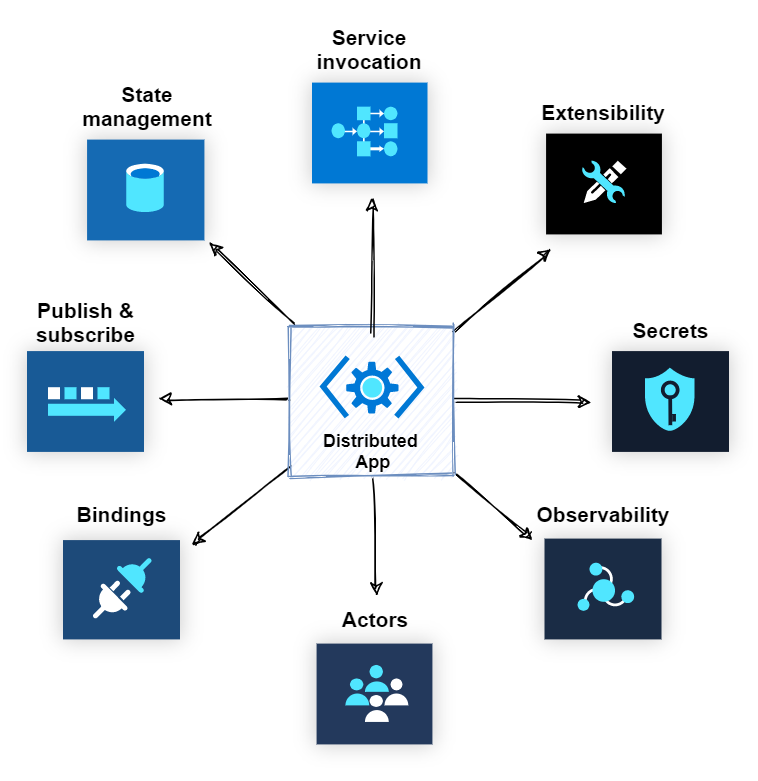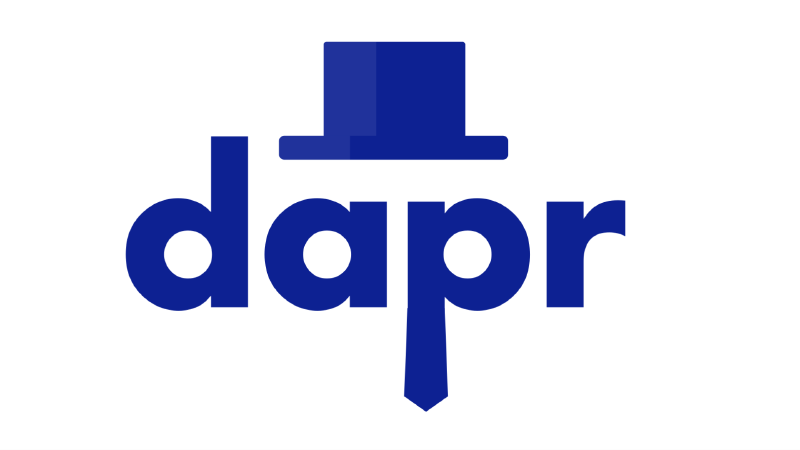Introducing Dapr: Simplifying Microservices in the Real World
Welcome to a new series on building modern, scalable applications with Dapr — the Distributed Application Runtime. Whether you’re wrestling with the limitations of a growing monolith or navigating the complexity of a microservices architecture, you’re in the right place.
This series is for developers and architects who want to streamline distributed systems without reinventing the wheel. We’ll walk through the real challenges of building resilient cloud-native apps — and how Dapr helps solve them.
What Will You Learn?
Over the next few articles, we’ll help you answer key questions like:
- Why are so many teams abandoning monoliths for microservices?
- What makes microservices harder than they look?
- How can Dapr simplify microservices development with reusable building blocks?
- What does Dapr look like in practice — with real code, real problems, and real solutions?
Whether you’re new to microservices or looking to level up your architecture, this series is designed to give you clarity, confidence, and hands-on value.
Why Dapr, and Why Now?
As applications grow, monolithic architectures start to show their limits. You may move to microservices for flexibility, but soon face new headaches: service discovery, retries, state management, pub/sub communication, secure secrets, and more.
That’s where Dapr comes in.
Dapr is a lightweight runtime that provides drop-in building blocks for distributed applications. Instead of wiring up infrastructure for every microservice concern, Dapr handles the plumbing — so you can focus on business logic, not boilerplate.
It’s not just a framework — it’s a sidecar that works with any language, any cloud, and any container platform.
Ready to rethink how you approach distributed systems?
In the next section, we’ll start where many journeys begin — with the monolith. What’s wrong with it, what it gets right, and why so many teams eventually outgrow it.
Let’s get into it.
The Monolithic Dilemma
Before we talk solutions, we need to understand the problem — and for many teams, that problem starts with the monolith.
What’s a Monolith, Really?
A monolith is a single, tightly integrated application where all components — UI, business logic, data access — live in one place. It’s like a Swiss Army knife: one unit that does everything, all bundled together.
In the early days, monoliths feel efficient:
- Everything’s in one codebase.
- You deploy once.
- Testing and debugging are localised and predictable.
So far, so good.
When the Monolith Starts to Strain
But as your app grows, cracks begin to show — and the things that once made monoliths convenient start slowing you down.
Scalability & Deployment Bottlenecks
You want to scale one feature — but have to deploy and scale the entire app. A small change means redeploying the whole thing. That’s not just inefficient — it’s risky.
Developer Friction
With more people in the same codebase, merges get messy. A bug in one part can break others. The blast radius of change is huge.
Locked-in Technology
Trying out new tools, frameworks, or languages? Not happening — everything’s married to your original stack.
What once felt like a simple solution becomes a bottleneck for speed, scale, and innovation.
Time to Break It Up
That’s why many teams hit a breaking point — and start looking for alternatives. The natural next step is microservices: smaller, modular services you can build, scale, and deploy independently.
It sounds like freedom — and in many ways, it is. But as we’ll see next, microservices bring their own set of problems.
And that’s exactly where Dapr enters the picture.
We’re not ready to dive into it just yet — but keep Dapr in mind as we explore the promises and pitfalls of microservices next.
From Monolith to Microservices — and the Hidden Complexity
You’ve outgrown the monolith.
That all-in-one codebase that once made life simple now feels like an anchor. Updates take forever. Scaling is all-or-nothing. Changing one thing breaks another. Teams trip over each other in version control. You’re ready for something more modular, more scalable, more modern.
So you follow the lead of engineering giants like Netflix and Microsoft and adopt microservices.
And for a while? It’s glorious.
- Teams move faster with smaller, independent codebases
- You deploy features without waiting on the entire app
- You scale what needs scaling — and nothing else
- You try out new tech without dragging the whole stack along
This is the microservices promise: faster velocity, team autonomy, and technical flexibility.
But then… the trade-offs start hitting.
The Trade-Off Nobody Told You About
The moment you break up your monolith, you’re no longer building an app — you’re building a system of apps. A distributed system.
Which means you’re now on the hook for:
Service Communication & Coordination
Getting services to talk to each other reliably takes more than just REST endpoints. You need:
- Service discovery
- Retry logic
- Secure communication
- Versioning strategies
- Load balancing
Suddenly, you’re writing infrastructure code instead of business logic.
Distributed State & Transactions
Each service has its own database? Great — until you need to keep data consistent across them. Now you’re wrangling eventual consistency, compensating actions, and distributed transactions. It’s fragile. And hard.
DevOps Overhead & Glue Code
You’re juggling:
- Helm charts
- Deployment scripts
- Service meshes
- Custom wrappers for metrics, secrets, retries, and configuration
Each team ends up reinventing basic patterns — and duct-taping them to Azure services like Key Vault, Cosmos DB, or Service Bus.
🔍 Monitoring & Debugging Across Services
When something breaks, where do you start?
You now need distributed tracing, log aggregation, request correlation, and structured telemetry — just to troubleshoot a user error.
Even in Azure — with tools like AKS and App Insights — you’re still wiring everything together by hand.
It’s no wonder many teams hit this wall. And it raises the question…
If microservices give us all this freedom, why does it feel so hard to build with them?
That’s Where Dapr Comes In
These aren’t edge cases — they’re core problems of working with microservices. And they’re exactly what Dapr was built to solve.
Dapr (Distributed Application Runtime) is an open-source, portable runtime that gives your services a consistent set of APIs for:
- Service-to-service invocation
- State management
- Pub/sub messaging
- Secrets
- Observability
- Bindings
- And more
Think of Dapr as the missing infrastructure sidecar for microservices — handling the boilerplate and distributed system glue so you can focus on writing your business logic.
And the best part? It fits right into Azure — integrating seamlessly with AKS, Azure Monitor, Cosmos DB, Service Bus, and Key Vault.
Coming Up: What Dapr Actually Does (And How to Use It)
In the next section, we’ll break down how Dapr works, walk through its core features, and show you exactly how it can simplify your microservices journey — without giving up flexibility or control.
If you’ve ever felt like building distributed systems meant rebuilding the plumbing from scratch every time, Dapr might just be the toolkit you’ve been looking for.
Let’s dive in.
Introducing Dapr: A Lightweight Runtime for Distributed Apps
Modern microservices architectures promise agility, scalability, and independent deployments — but they also introduce real-world complexity. As soon as your system shifts from a monolith to distributed services, you inherit a new class of challenges: service discovery, state management, secure communication, retries, observability, and more.
This is where Dapr comes in.

What Is Dapr?
Dapr (Distributed Application Runtime) is an open-source, portable runtime that helps developers build distributed applications more easily. Instead of reinventing the wheel for common microservices problems, Dapr gives you a set of modular building blocks — ready to plug into any application, in any language, running on any infrastructure.
Think of it as a sidecar companion to your microservices. It runs alongside your app, exposing HTTP or gRPC APIs that simplify the toughest parts of distributed system development. Your app talks to Dapr — and Dapr talks to the infrastructure.
✅ Language-agnostic (C#, Java, Python, Go, Node.js, and more)
✅ Runs anywhere (local dev, Kubernetes, edge, or cloud)
✅ Drop-in building blocks — no SDK required
✅ Works great with Azure (Cosmos DB, Key Vault, Service Bus, AKS, and more)
Where Dapr Fits in the Cloud-Native Landscape
Dapr is part of the Cloud Native Computing Foundation (CNCF) ecosystem, sitting at the application layer — above container platforms like Kubernetes, and adjacent to tools like service meshes or event brokers. Unlike a full service mesh, Dapr doesn’t control traffic routing or mesh policies — it focuses on developer-facing patterns like service invocation, pub/sub, state management, and secrets.
You don’t need to change how you deploy your services. Just run Dapr as a sidecar next to each microservice, and let it handle the cross-cutting concerns.
Why Dapr Matters
Dapr helps you:
- Decouple your app logic from infrastructure concerns
- Avoid boilerplate code for things like retries, service discovery, or binding to message queues
- Stay flexible — you can change your infrastructure (e.g., switch from Redis to Cosmos DB) without changing your application code
- Keep your architecture clean and portable, even as your app grows more complex
Whether you’re building in Azure or running across clouds, Dapr gives you a consistent developer experience — without locking you into a single vendor.
A Preview of What’s Inside
Dapr is made up of building blocks — each one solving a common challenge in microservices development. These include:
- Service-to-service invocation
- State management
- Pub/sub messaging
- Bindings to external systems
- Secrets management
- Observability (metrics and tracing)
- Actor-based concurrency support
- And more…
We’ll explore these capabilities in the next section. But first, just know this:
Dapr helps you write less glue code and spend more time on actual business logic.
Inside Dapr: The Building Blocks That Make It Work
In the previous section, we introduced Dapr as a lightweight runtime that simplifies microservices development. Now, let’s unpack what that actually means — by exploring the building blocks that make Dapr so powerful.

Each Dapr building block addresses a core challenge in distributed systems — from service communication to state handling, from secret management to observability. You can use them independently, combine them as needed, and adopt them incrementally without rewriting your app.
Let’s look at them grouped by use case.
Communication & Integration
Service Invocation
Dapr provides reliable, secure service-to-service calls using HTTP or gRPC. It handles service discovery, retries, and mTLS under the hood — no load balancer or custom client logic required.
Use case: Call another microservice without worrying about its hostname or failover logic.
Azure fit: Ideal for AKS-based services needing secure, discoverable communication.
Publish & Subscribe (Pub/Sub)
Dapr simplifies event-driven communication with a built-in pub/sub API. You publish events to a topic; subscribers react — without knowing who sent what.
Use case: Decouple services using events (e.g., order placed → notify inventory, billing).
Azure fit: Works with Azure Service Bus or Event Hubs as drop-in brokers.
Bindings
Bindings allow your service to send or receive data from external systems like databases, queues, and storage — without writing SDK code or infrastructure glue.
Use case: Trigger your app from a blob upload or write to a queue.
Azure fit: Integrates with Event Grid, Storage Queues, and more.
State & Behavior
State Management
With Dapr’s state API, you can store key-value state reliably — without wiring up caching, persistence, or transactions manually.
Use case: Maintain shopping cart state, session data, or workflow checkpoints.
Azure fit: Swap between Redis, Cosmos DB, or Blob Storage without changing code.
Actors
Need concurrency-safe, stateful microservices? Dapr supports the virtual actor model, perfect for scenarios like IoT device control, game state, or timers.
Use case: Build stateful services with isolated, per-entity logic.
Azure fit: Run distributed actors reliably inside AKS clusters.
Security & Secrets
Secrets Management
Instead of hardcoding secrets or managing config files, use Dapr’s secrets API to securely retrieve credentials from a central store.
Use case: Access API keys, connection strings, or tokens without leaking them in code.
Azure fit: Seamless integration with Azure Key Vault.
Observability & Extensibility
Observability
Dapr captures distributed tracing, metrics, and logs out of the box. It supports OpenTelemetry, and integrates cleanly with monitoring stacks.
Use case: Trace a request across services or identify a slow function call.
Azure fit: Push metrics and traces to Azure Monitor or Application Insights.
Extensibility
Dapr is modular — you can extend it with custom components, swap implementations (e.g., Redis ↔ Cosmos DB), or build your own plugins.
Use case: Add support for a proprietary message broker or secret store.
Azure fit: Choose Azure-native services, or plug in third-party or hybrid solutions.
Putting It All Together
You don’t need to use every Dapr feature to get value. Many teams start with just one or two blocks — like state management or service invocation — and expand over time. Dapr’s sidecar model means you can introduce it gradually, without rewriting your app or adopting everything at once.
Bonus: Since Dapr speaks HTTP/gRPC, your services stay loosely coupled. You’re not tied to any Dapr SDK — just APIs.
In our next article, we’ll move from concepts to code. You’ll set up a local Dapr development environment, see how the sidecar works in action, and build your first microservice using Dapr’s building blocks.
Get ready to ship faster, scale smarter, and write less boilerplate.
Conclusion: From Complexity to Clarity with Dapr
Now you know what Dapr is, why it matters, and how it helps you simplify the real-world challenges of microservices. From service invocation to state management, pub/sub messaging to observability — Dapr gives you clean, consistent APIs that plug into your app without getting in the way.
Whether you’re running on Azure, Kubernetes, or local dev, Dapr makes cloud-native architecture feel approachable — not overwhelming.
In the next article, we’ll move from ideas to action. You’ll set up Dapr locally, see how the sidecar works in practice, and build your first microservice using Dapr’s building blocks. Real code. Real insights. No magic — just better building.
👉 Ready to start building with Dapr? Let’s dive into Part 2: Getting Started with Core Concepts.
